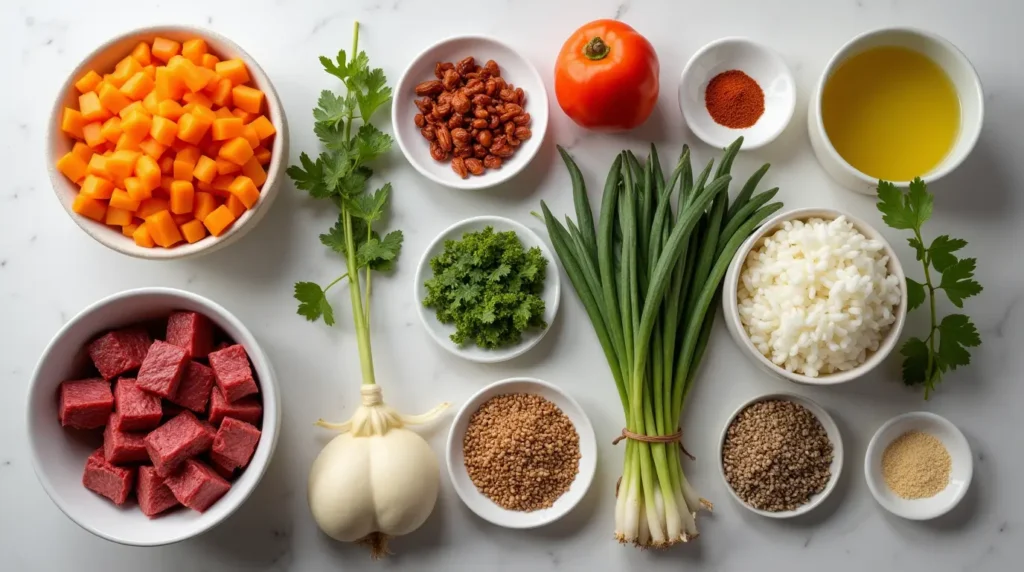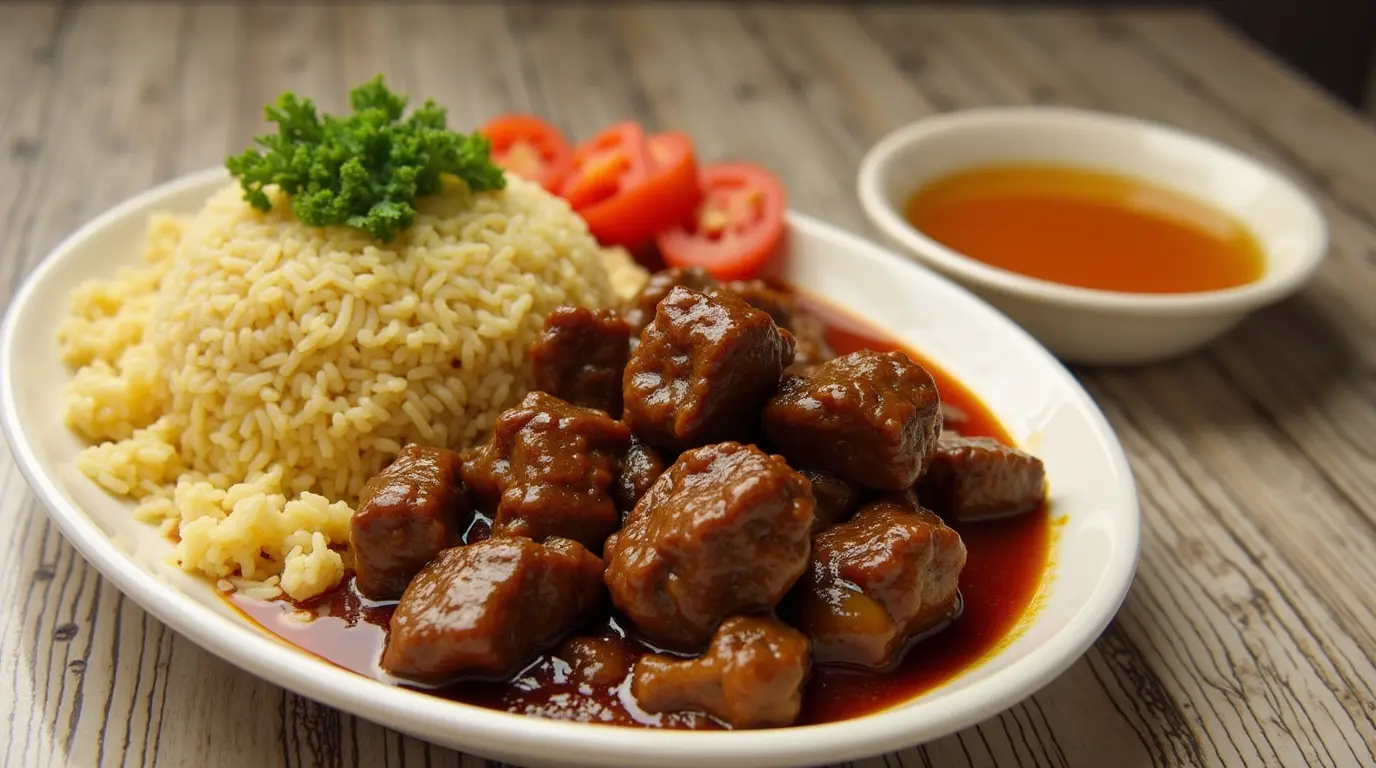Beef pares isn’t just a meal, it’s a Filipino street food classic.
Tender beef simmered in sweet-savory soy sauce, paired with garlic rice and broth, makes this dish a complete comfort experience. And yes, you can make it at home, no takeout required.
Table of contents
Essential Ingredients for Perfect Beef Pares
To make authentic Beef Pares, you’ll need to stock up on a few key ingredients. Let’s break down their roles and how to select the best ones

Choosing the Right Cut of Beef
The heart of any great Beef Pares lies in the beef itself. Brisket is the most popular choice because it’s marbled with fat, which keeps the meat juicy and flavorful after long cooking. Alternatively, beef shank or short ribs work just as well. The goal is tender, fall-apart meat that soaks up the sauce like a sponge.
Traditional Spices and Flavor Enhancers
Beef Pares wouldn’t be the same without its aromatic spices. Star anise is the star (pun intended), lending a slightly sweet, licorice-like flavor that sets the dish apart. Ginger and garlic add warmth and earthiness, while soy sauce provides the umami kick.
“Think of these spices as the orchestra, each playing its part to create a symphony of flavors.”
Alternative Ingredients for Dietary Preferences
What if you’re cooking for someone who prefers a healthier or non-traditional take? No worries! Swap out beef for leaner proteins like chicken or even tofu for a vegetarian version. You can also use coconut sugar or honey as a substitute for granulated sugar to make the dish a bit healthier.
Step-by-Step Guide to Cooking Beef Pares
Now that you’ve got your ingredients ready, it’s time to roll up your sleeves and cook! Beef Pares may seem intimidating at first, but with a bit of patience and practice, you’ll be amazed at how rewarding it is to make this dish from scratch.
Preparing the Beef for Cooking
- Trim and Cut: Start by trimming excess fat from the beef, then cut it into bite-sized chunks.
- Marinate: In a bowl, combine soy sauce, sugar, garlic, and ginger, and let the beef marinate for at least an hour. This step helps the flavors penetrate the meat deeply.
Crafting the Signature Sweet and Savory Sauce
- Sauté Aromatics: Heat a pot with a bit of oil and sauté garlic, onion, and ginger until fragrant.
- Add Spices: Toss in the star anise and let it release its aroma.
- Simmer with Love: Pour in the marinade and water, then let the beef simmer for 1-2 hours until tender.
Love sweet-savory flavor blends? Try our Beijing Beef Sauce for another bold, umami-packed option.
Cooking and Simmering Techniques for Tender Meat
The secret to achieving that melt-in-your-mouth texture lies in the simmering process. Keep the heat low and let time do the work. Avoid stirring too much to prevent breaking the beef chunks. If you’re short on time, a pressure cooker is your best friend it cuts down cooking time while preserving the flavors.
Side Dishes and Pairings for Beef Pares
No Beef Pares meal is complete without the right accompaniments. The rich flavors of the dish pair wonderfully with sides that balance its intensity.
The Perfect Fried Rice to Accompany Beef Pares
Fried rice is the classic pairing, adding a touch of crunch and smokiness. Use day-old rice for the best results it’s less sticky and easier to fry. Toss it with garlic, soy sauce, and a bit of butter for an irresistible side.
Popular Vegetable Side Dishes to Complete the Meal
Want to add a splash of color and nutrition? Steamed bok choy, sautéed kangkong (water spinach), or pickled vegetables make excellent choices. Their mild, tangy flavors cut through the richness of the beef.
Looking for simpler Filipino-inspired dishes? Explore our quick & easy recipes collection, flavorful meals without the fuss.
Tips for Perfecting Your Beef Pares Recipe
Even if you’ve mastered the basics, there’s always room to elevate your Beef Pares game. These tips and tricks will help you turn a good dish into a spectacular one.
How to Achieve the Ideal Balance of Flavors
The secret to achieving a well-balanced Beef Pares lies in layering flavors. Each step in the cooking process adds depth to the dish, so don’t rush it.
Tips:
- Start with Aromatics: Sautéing garlic, onion, and ginger releases their natural sweetness and forms the flavor base.
- Caramelization is Key: Let the sugar caramelize slightly before adding the liquid it enhances the dish’s richness.
- Rest the Dish: Let the Beef Pares sit for a few minutes after cooking. The flavors meld together better, much like a fine wine.
The Role of Marination in Flavor Development
Marinating the beef isn’t just a step it’s a game-changer. A good marinade not only tenderizes the meat but also infuses it with complex flavors that make every bite irresistible.
Pro Tip:
- Include a bit of sesame oil in the marinade for a subtle nutty aroma that complements the dish’s sweetness.
Storing and Reheating Leftover Beef Pares
One of the best things about Beef Pares is that it tastes even better the next day. The flavors deepen as they sit, making leftovers a real treat.
Storage Tips:
- Refrigeration: Store in an airtight container in the fridge for up to 3 days.
- Freezing: For longer storage, freeze the dish in portions. Thaw overnight before reheating.
Reheating Tips:
- Reheat gently on the stovetop over low heat, adding a splash of water or stock to loosen the sauce. Avoid microwaving, as it can dry out the meat.
“Beef Pares is the gift that keeps on giving leftovers are like a reward for all your hard work in the kitchen.”
Making Beef Pares Healthier: Tips and Tricks
If you’re trying to enjoy Beef Pares while keeping it on the healthier side, there are several ways to lighten up the dish without sacrificing flavor.
Reducing Fat Content Without Sacrificing Flavor
Switching to leaner cuts of beef is the easiest way to cut down on fat. However, this can sometimes result in a less tender texture.
Tips:
- Use a pressure cooker or slow cooker to tenderize leaner cuts like sirloin or round.
- Skim off excess fat from the sauce during cooking for a cleaner finish.
Substituting Sugar with Healthier Alternatives
If you’re watching your sugar intake, there are plenty of substitutes that work well in Beef Pares.
Alternatives:
- Coconut sugar or stevia for a natural sweetness.
- Honey for a slightly floral, aromatic flavor.
Serving Beef Pares for Special Occasions
Beef Pares isn’t just a comforting everyday meal; it’s also a show-stopper for special occasions. Whether you’re hosting a casual get-together or a Filipino-themed dinner party, this dish can easily take center stage.
Plating Ideas for a Festive Presentation
Presentation matters, especially when you’re serving a dish as rich and flavorful as Beef Pares. A little creativity can elevate your meal from homey to restaurant-worthy.
Tips for Plating:
- Use Wide Bowls: Serve the beef in a shallow bowl to highlight its glossy sauce.
- Garnish Generously: Sprinkle chopped green onions, sesame seeds, or fried garlic on top for added texture and a pop of color.
- Rice Molds: Shape your fried rice into neat domes using a small bowl or ramekin. This adds visual appeal and keeps the plate tidy.
Hosting a Filipino-Themed Dinner Party
If you’re planning a Filipino-themed dinner party, Beef Pares is an excellent main dish. Pair it with other traditional Filipino fare like lumpia (spring rolls), pancit (noodles), and halo-halo (dessert). Serve calamansi juice or San Miguel beer for an authentic dining experience.
Pro Tip:
- Create a mini buffet with small servings of garlic rice, soup, and Beef Pares. Guests can assemble their plates and enjoy a bit of everything.
For more soulful, comforting Filipino-style meals, browse our Grandma’s recipes, timeless flavors straight from the heart.
Frequently Asked Questions (FAQs)
What does “pares” mean in beef pares?
“Pares” is a Filipino term meaning “pair.” It refers to the pairing of beef stew, garlic fried rice, and clear broth traditionally served together.
Can I make beef pares in a pressure cooker?
Yes, using a pressure cooker cuts cooking time significantly. Cook the beef under pressure for about 30 minutes until fork-tender.
What’s the best cut of beef for pares?
Beef brisket or beef shank are ideal. They become tender with slow cooking and absorb the rich sauce beautifully.
How is beef pares different from adobo or caldereta?
Pares has a sweeter soy-garlic profile with star anise and sugar, while adobo is more vinegary and caldereta is tomato-based with vegetables.

